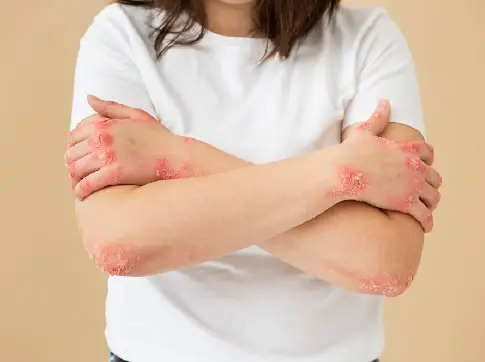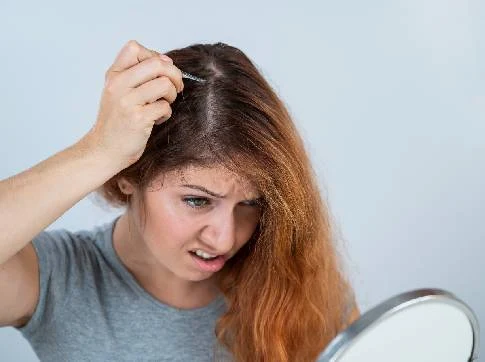Common Skin Diseases and Their Treatment: Guide By A Dermatologist
07 Oct 2023 Posted By Skinlogics
The skin is the body's largest organ and has several important functions. It covers and protects the entire body, acting as a barrier against environmental factors and preventing harmful pathogens from entering. However, sometimes bacteria and other pathogens can lead to skin diseases. This often happens when bacteria or pathogens find their way into the body through a cut, break, or wound in the skin. Skin infections can also develop in areas where skin rubs against skin, especially in moist areas. Infections can also occur when a part of the body doesn't receive enough blood supply or when the immune system is weakened due to another illness or medical treatment.
In this blog post, the skin doctor in Noida at Skinlogics provides the readers with a list of a few common skin diseases and conditions along with their treatment.
Acne
Acne is a prevalent skin problem that affects both teenagers and adults. It is caused by an excess of skin sebum (oil) produced by the sebaceous glands, which subsequently clogs pores along with other skin impurities. There are two types of acne: non-inflammatory or inflammatory acne. Inflammatory acne like pimples, pustules, cysts, and nodules are the result of bacteria plugging the skin pores. Non-inflammatory acne types include blackheads and whiteheads.
Treatment for mild acne is the use of over-the-counter or topical medications. Oral drugs such as anti-inflammatory medications, antibiotics, oral contraceptive pills, and Roa-ccutane are needed to treat moderate to severe acne.
Allergies
When the skin shows a hypersensitivity reaction such as a skin rash or being exposed to a certain substance, food, object, or chemical, it is known as an allergy. Contact allergic dermatitis and urticaria (hives) are the most prevalent skin allergies. Contact allergic dermatitis may appear in a variety of ways, the most frequent of which are red, scaly, itchy markings that can blister and leak in severe cases. Skin-prick testing can help people figure out what allergies they have.
Treatment of skin allergies by dermatologists in Noida at Skinlogics like contact dermatitis involves the use of hydrocortisone cream, ointments like calamine lotion, use of cold compresses, drugs like antihistamines, or oatmeal baths.
Eczema
Eczema, also known as atopic dermatitis, is a common skin condition that causes dry, red, itchy, and irritated skin that can break and bleed easily. It results in increased skin inflammation and a weakened skin barrier, making it more vulnerable to irritants and allergens.
Treatments for eczema include the use of gentle skin moisturisers, topical medications like steroids, oral drugs like antihistamines, corticosteroids, or anti-inflammatory medications; immunosuppressant drugs, light therapy, and avoiding triggers that flare up eczema.
Heat Rash
Heat rash, also known as sweat rash, is caused by a blockage and inflammation of sweat ducts in the skin during extreme heat and humid weather. When the sweat glands in the skin become blocked, the sweat produced cannot reach the surface of the skin to evaporate. As a result, sweat is diverted into surrounding tissue, resulting in stinging and prickling feelings. Miliaria is the medical term for this condition.
Heat rash is treatable at home by keeping the skin cool and dry, wearing loose-fitting cotton clothing, using anti-itch medications, and taking medications (if heat rash is induced by high fever).
Hives (Urticaria)
Hives are an eruption of swollen, itchy, pale red bumps or plaques on the skin. It develops unexpectedly and usually cures itself within a few hours to days. The lesions spread throughout the body. It can be the result of an allergic reaction to anything as simple as food or an insect sting.
Medications such as anti-itch drugs, antihistamines, or corticosteroids and avoidance of identified triggers are part of its treatment. Besides, hives symptoms can also be relieved by applying cold or taking a cool bath, sun-protecting the skin, or wearing loose-fitting cotton clothing.
Impetigo
Impetigo is a highly contagious, superficial skin infection that primarily affects younger people; however, it can affect anyone at any age. This infection can appear as mild irritating blisters that develop into pustules and erupt quickly, leaving a honey-colored crust. It is frequently visible around the nose and lips. It most commonly affects the face, neck, and hands of young children and newborns. The most common bacteria that cause impetigo are Streptococcus pyogenes and Staphylococcus aureus.
Topical antibiotics alone or in combination with systemic antibiotics are used to treat impetigo.
Psoriasis
Psoriasis is a chronic, hereditary skin disorder characterised by large, red, scaly areas on the skin. This medical condition is the result of excessive skin cell proliferation. Parts of the body that are prone to psoriasis can develop as many skin cells in a few days as normal skin develops in a month. This rapid growth is usually visible by silvery scales on the skin. The scales might become irritated and appear red. These scaly patches appear on the sufferer's elbows, knees, scalp, and chest. Nails and joints may also be affected.
Treatment of psoriasis aims to stop the growth of skin cells and remove scales. Options include topical therapy with corticosteroids, Vitamin D analogs, calcineurin inhibitors, reti-noids, salicylic acid, or anthralin; phototherapy; oral/injectable medications such as steroids, biologics, cyclosporine, and retin-oids.
Rash
This medical term refers to a change in the colour, texture, or appearance of the skin. Itching and other symptoms, such as fever and chills, may present along with a rash. Rashes can appear as red, flat spots, raised bumps, blisters, welts, or any combination of these. It is not uncommon for the rash to spread to most or all of the body before disappearing. Rashes can persist for several days or weeks.
Treatment of a skin rash will depend upon its cause. Self-care is also important.
Ringworm
Ringworm (tinea) is a common skin condition caused by a dermatophyte fungal infection. The term comes from the appearance of skin lesions, which are commonly in the shape of a ring or resemble a worm under the skin. The fungus causing ringworm can infect the skin, nails, and hair and is highly contagious. There are different forms of tinea named after the affected area of the skin. Tinea corporis is the medical term for ringworm (tinea) affecting the skin on the trunk, arms, and legs. Other forms include athlete's foot and jock itch.
Antifungal medications can help treat ringworm.
Rosacea
Rosacea is a widespread and persistent skin condition characterised by facial redness, papules, pustules, and edema. It results from tiny and superficially dilated blood vessels on the face. It is more common in people with fair skin and those aged 35–60 years. Rosacea is usually best described as an inflammatory skin condition, although nerve endings, blood vessels, genetics, and UV radiation all have a role to play in its occurrence.
Rosacea is usually treated with medications like oral acne drugs, oral antibiotics, and topical drugs to reduce flushing. Laser therapy can also be used.
Vitiligo
Vitiligo is a chronic, auto-immune skin disorder that causes patches of skin to lose pigmentation because of the destruction of pigment-producing cells in the skin melanocytes. This condition causes skin areas to appear unusually white. The white, patchy appearance of vitiligo can emerge after an injury or sunburn but the exact cause is still unknown. Sun protection is critical for individuals with vitiligo because the skin may only burn and not tan. Furthermore, sunburn can be a trauma that causes or spreads vitiligo.
To restore skin color, dermatologists prescribe medications like corticosteroids, calcipo-triene, tacrolimus ointment pimecrolimus cream, or JAK inhibitor or may perform light therapy. In severe cases, dermatologist in Noida recommend surgeries like cell transplants and skin grafts.
Wart
A wart, also known as a plantar wart, verrucae, or papilloma, is a foot growth caused by the Human Papillomavirus (HPV).
Warts are extremely common in children and patients with weakened immune systems. Warts can be single and spherical, or they can form in uneven clusters, which are known as mosaic warts. When warts appear in a weight-bearing area of the foot, they will develop into the skin's superficial layers. They can push on nerve endings and frequently cause discomfort.
Strong peeling medication (like salicylic acid), cryotherapy, laser therapy, or minor surgery can help remove warts.
Yeast Skin Infection
A yeast infection on the face is a form of cutaneous candidiasis, which is a type of skin infection. Candidiasis is a fungal infection caused by candida yeast- one of the many yeasts that dwell on the skin. It is usually not a problem for healthy people. When candida overgrowth occurs, it can dig beneath the surface of the skin. It can result in a rash or a skin infection. Cutaneous candidiasis can occur practically everywhere on the skin's surface, including the face.
Oral candidiasis is characterized by a yeast infection on the lips. Oral candidiasis is also known as oral thrush. Oral thrush develops when candida overgrowth occurs in the mouth.
Antifungal medications prescribed by skin infection doctors in Noida can help treat candidiasis.
If you're experiencing any skin issues and seeking expert care, don't hesitate to reach out to the skilled professionals at Skinlogics, the premier skin clinic in Noida. Our team of experienced experts is dedicated to helping you achieve radiant and healthy skin that is not only free from problems but also in optimal condition.
Skinlogics Clinic prioritizes skin's well-being and provides tailored solutions to address your unique concerns, ensuring that you can confidently put your best face forward. Get in touch for more details today!
Also Read: Seasonal Skin Care - Tips By A Dermatologist


